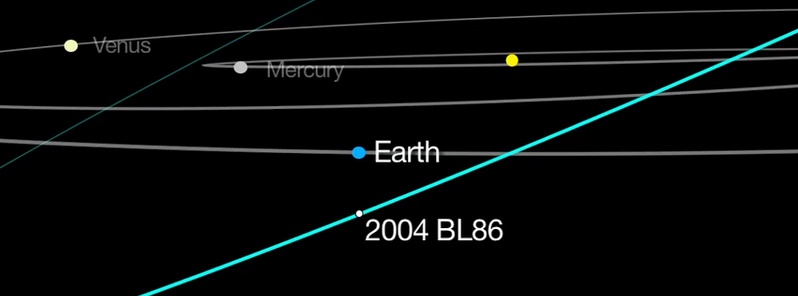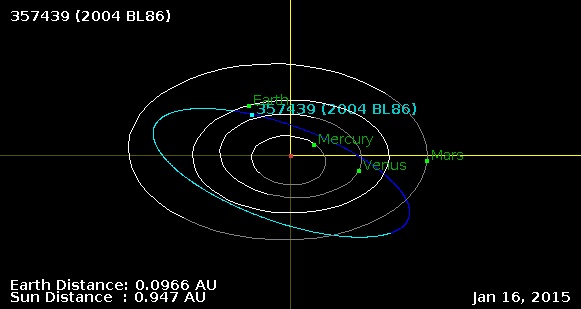Asteroid 2004 BL86 to safely flyby Earth on January 26

Asteroid 2004 BL86 will flyby our planet at a safe distance of approximately 1.2 million km (745 000 miles) at 16:20 UTC on January 26, 2015. This is about three times the distance of Earth to the Moon.
Based on its reflected brightness, astronomers estimate that this asteroid is about 500 meters (about a third of a mile) in size. The flyby of 2004 BL86 will be the closest by any known space rock this large until asteroid 1999 AN10 flies past Earth in 2027, JPL reports.
2004 BL86 is traveling at a speed of 56 520 km/h (35 057 mph) and will reach visual magnitude of 9. Its maximum brightness may occur between 04:07 and 04:52 UTC on January 27.
Virtual Telescope will offer free live streaming of its close approach. Their show, with real time images and commentary, will start at 19:30 UTC on January 26.
|
357439 (2004 BL86) |
| Classification: Apollo [NEO, PHA] SPK-ID: 2357439 |
| [ Ephemeris | Orbit Diagram | Orbital Elements | Physical Parameters | Discovery Circumstances | Close-Approach Data ] |

Asteroid 2004 BL86 orbit diagram by JPL
"Monday, January 26 will be the closest asteroid 2004 BL86 will get to Earth for at least the next 200 years," said Don Yeomans, who is retiring as manager of NASA's Near Earth Object Program Office at the JPL, after 16 years in the position. "And while it poses no threat to Earth for the foreseeable future, it's a relatively close approach by a relatively large asteroid, so it provides us a unique opportunity to observe and learn more."
One way NASA scientists plan to learn more about 2004 BL86 is to observe it with microwaves. NASA's Deep Space Network antenna at Goldstone, California, and the Arecibo Observatory in Puerto Rico will attempt to acquire science data and radar-generated images of the asteroid during the days surrounding its closest approach to Earth.
"When we get our radar data back the day after the flyby, we will have the first detailed images," said radar astronomer Lance Benner of JPL, the principal investigator for the Goldstone radar observations of the asteroid. "At present, we know almost nothing about the asteroid, so there are bound to be surprises."
"Asteroids are something special. Not only did asteroids provide Earth with the building blocks of life and much of its water, but in the future, they will become valuable resources for mineral ores and other vital natural resources. They will also become the fueling stops for humanity as we continue to explore our solar system. There is something about asteroids that makes me want to look up," Yeomans said.
This asteroid was initially discovered on January 30, 2004 by a telescope of the Lincoln Near-Earth Asteroid Research (LINEAR) survey in White Sands, New Mexico.

2004 BL86 is on the list of Potentially Hazardous Asteroids (PHA). PHAs are currently defined based on parameters that measure the asteroid's potential to make threatening close approaches to the Earth. Specifically, all asteroids with an Earth Minimum Orbit Intersection Distance (MOID) of 0.05 AU or less and an absolute magnitude (H) of 22.0 or less are considered PHAs. In other words, asteroids that can't get any closer to the Earth (i.e. MOID) than 0.05 AU (roughly 7 480 000 km or 4 650 000 miles) or are smaller than about 150 m (500 feet) in diameter (i.e. H = 22.0 with assumed albedo of 13%) are not considered PHAs.
This "potential'' to make close Earth approaches does not mean a PHA will impact the Earth. It only means there is a possibility for such a threat, JPL explains.
The list of all known Potentially Hazardous Asteroids (PHAs) is here.
Featured image credit: NASA/JPL

Very interesting read!
A giant asteroid will strike the earth at some point with catastrophic results. I read about it in a book called Symbols of the Revelation by Robert B. Dearmore